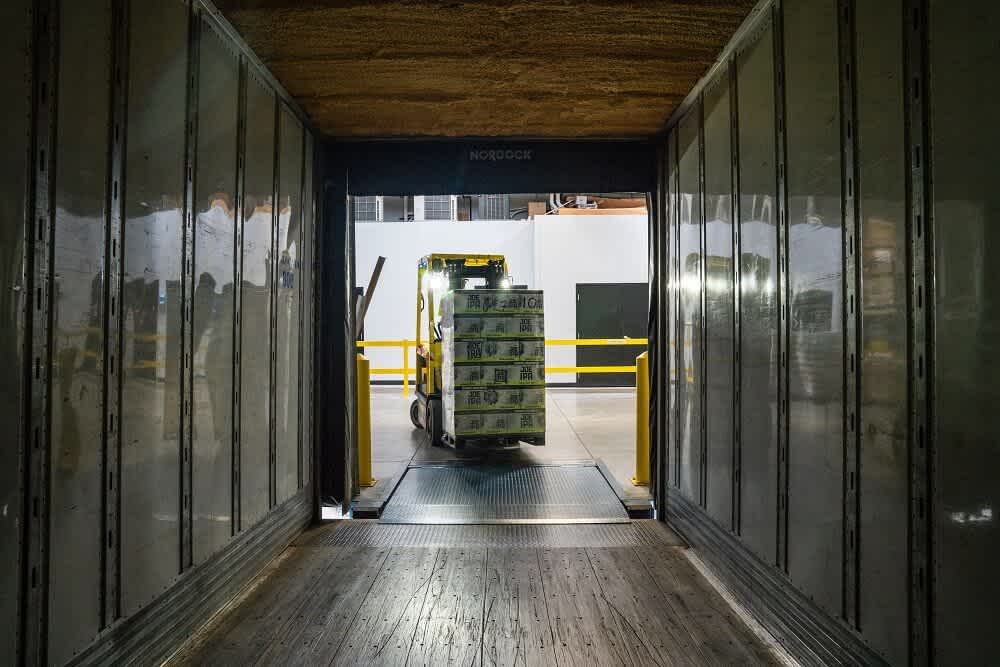
by Sam Franklin | September 13, 2022 | 12 min read
What is order picking, and how can you make the process more efficient?
Get fundedLast updated: October 06, 2022
In warehouse order picking, you pick the individual items a customer has ordered. It’s similar to having a shopping list when we go to the supermarket. One by one, we pick the items until we complete our list.
In a warehouse setting, though, it’s a lot more complex, time-consuming and labour-intensive. In fact, order picking is the most labour-intensive activity in most warehouses (as mentioned in a book prepared by the world’s largest supply chain and logistics leadership institute).
With this in mind, a slight improvement in warehouse picking can help businesses save time and lower their operating costs. This, in turn, leads to faster and cheaper order fulfilment, which results in increased profitability and better customer experience (customers receive their orders faster).
Table of contents
- How can you improve order picking efficiency
- How to analyse your order picking operations
- Improving your order picking efficiency
- Common warehouse layouts
- What are the technologies and tools in order picking?
- Conclusion
How can you improve order picking efficiency
As with other logistics operations, improvement in warehouse picking starts with assessment and analysis. Then, according to your findings, you can choose the right one among the warehouse picking strategies. You can also modify your warehouse layout and the arrangement and positioning of your products or SKUs. The ultimate goal is to minimise waste in your warehouse picking operations.
How to analyse your order picking operations
To analyse what happens during the warehouse picking process and find out which specific steps to improve, you can do the following:
Look at your bestsellers and fast-moving goods
Conduct a Gemba walk (you watch the process and spot waste and inefficiencies)
Ask your team where the bottlenecks are
Beware of averages (pay attention to trends and seasonality)
Set up KPIs and benchmarks
Look at your bestsellers and fast-moving goods
Rank your products and SKUs according to sales volume and frequency as well as GBP amount. Then, you can store your bestsellers and your fast-moving goods together. With this, your team can make more picks in a small area and complete each picking list much faster. This reduces their travel time and allows them to make more picks throughout the day.
Conduct a Gemba walk
In a Gemba walk, you observe the actual work process and ask your team about the challenges and bottlenecks. The goal is to better understand the process and spot opportunities for improvement.
While doing a Gemba walk, you can list and outline the individual steps in the process and their relation to one another. The steps may include:
Receiving the customer order
Verifying inventory is available for the order
Generating the pick list to guide the picking process
Scheduling the order picking
Producing and processing the necessary documentation (paperwork)
You should talk with all the teams and personnel involved in each step. This includes those who operate the equipment and handle the paperwork, not just individual order pickers. This way, you can find out which challenges they face and the things that slow them down (e.g. perhaps it takes too long for the equipment to be ready or that paperwork requires too many approvals).
Ask about the bottlenecks
When talking with your team, it helps to ask about bottlenecks. A bottleneck stops or slows down the flow of the entire process, no matter how fast or efficient the other steps are. The bottleneck could be in receiving the customer order, generating the pick list or processing the paperwork.
Once you identify the bottleneck, you should then find ways to remove it or at least lighten the burden in that step. The goal is to smoothen the workflow so that the entire process moves along without many delays and obstacles.
Focus on trends and seasonality
Earlier, we mentioned that it’s good to look at your bestsellers and fast-moving goods. It’s also good to look at the times they’re being ordered. This seasonality and sudden peak can drastically affect how inventory moves in and out of your warehouse. For example, a sudden peak can reveal where the bottleneck is. This will slow down the entire process and perhaps cause other delays downstream (and ultimately, the customer might receive the order late).
It’s good to anticipate those sudden peaks so your order picking process is always smooth. You can look at your warehouse reports and history to identify the seasonality and peaks. You can also look at the upcoming holidays and other events that might cause a surge in customer orders.
Set up KPIs and benchmarks
Key performance indicators (KPIs) tell you whether you’re making progress or you’re keeping your business on track. In other words, KPIs help tell you how healthy your business is.
For example, in order picking you have to always look at your order cycle time (both total and internal):
Internal order cycle time (how long you do the picking for each customer order)
Total order cycle time (how long you process each customer order from the moment you receive it until it’s ready for shipment)
Because warehouse picking can take more than half of the total order cycle time, lowering the internal order cycle time can also drastically lower your total order cycle time. The goal is to lower the cycle time so you can complete more daily orders.
Aside from order cycle time, also look at the order picking accuracy. If your accuracy is low, this means your customers are frequently returning your products. This can hurt the entire business because most of those customers won’t return or even leave a bad review which will repel future customers (because they see that customer satisfaction levels are low).
But if your order picking accuracy is high or near perfect, your customers will be delighted when they receive their order. This will also positively affect downstream if you’re handling orders for other suppliers and business clients. To help you accomplish this high accuracy and help ensure customer satisfaction, you might require better control standards or have your team undergo more in-depth training.
Improving your order picking efficiency
Now that you know how to assess your order picking operations and come up with a few ideas on how to improve them, the next step is to formulate specific strategies that will make your operations more efficient (especially when it comes to reducing your order pickers’ travel time).
To come up with an effective plan after studying your operations, it helps to familiarise yourself with the different warehouse picking strategies:
Discrete picking
Wave picking
Batch picking
Zone picking
Discrete picking
This is the most straightforward picking strategy, where you pick the individual items until the order is complete. This method is also the most similar to how we buy from the supermarket (pick the necessary items and put them all in one container). The discrete picking method is ideal for low-order volumes (e.g. you sell high-end or heavy products).
Wave picking
Wave picking is often a good choice if you sell or handle a high number of picks or SKUs for each order. In this picking strategy, the task is scheduled in waves or at specific times of the day. During each wave, all zones or designated areas are picked at the same time. Then, you sort the items and get them ready for individual shipments. This is in contrast to discrete picking, where no sorting happens.
Batch picking
In batch picking strategy, you do the picking for multiple orders in one trip (which drastically reduces your travel time). For example, if a particular SKU is included in multiple orders, you can just pick several items of that SKU instead of going back and forth for each order. You can also do this when your target items with different SKUs are in the same area. What happens here is that in one trip, you get to pick several SKUs and other items and then allocate them to individual orders later on.
Zone picking
This is also known as the pick-and-pass method. For instance, you’re assigned to a zone, and your focus is picking the SKUs there. Then, you pass it along, and other people from other individual zones do the same until the order is complete. The process is similar to an assembly line where each worker is assigned to a specific and repeatable task. The worker completes that task and passes it along to the next worker who has a different task. This goes on until the product is complete. In an order picking process, workers from each zone pick and pass the order until it’s complete and ready for individual shipment.
For low-volume operations, discrete packing is a practical choice. But for large-scale operations, especially when you’re handling many SKUs, zone picking is often preferred because it greatly reduces travel time (which takes up much of the order picking operation). It can also be partly automated if you install a conveyor belt. As a result, your order pickers can better focus on the actual picking than going back and forth in the warehouse.
Common warehouse layouts
Aside from the different order picking methods mentioned above (discrete, wave, batch and zone picking), it’s also good to familiarise yourself with the most common warehouse layouts:
U-shaped
I-shaped
L-shaped
U-shaped warehouse flow
In this layout, the goods move in a U shape because the receiving and dispatch are on the same side of the building. For example, at door A, several different goods in bulk come in, and the individual shipments come out (after picking and sorting) at door B. Both doors A and B, are on the same side of the building. This layout is common in small warehouses.
I-shaped flow
Here, the receiving is on one end, and the dispatch is on the other end of the building. As a result, the goods move in a single direction. This also allows for improved security because you can better monitor what comes in and out of your warehouse. This is in contrast to the U-shaped flow where mix-ups, confusion and security risks are possible.
L-shaped flow
You can often find this warehouse layout in cross-docking operations. In this type of operation, items move directly from receiving to shipping (or right after unloading, the goods are immediately loaded onto the next truck). It’s a high-speed warehouse operation where the turnover is measured in hours instead of the goods being stored for days, weeks or months inside the warehouse.
With the L-shaped flow, cross-docking becomes easier and faster. In high-volume crossdocks, though, these warehouses are long rectangles with several doors around them. The goods follow an L flow (or perpendicular flow) to shorten the travel time. Instead of going through the entire length of the building, the goods flow at shorter distances because of the L flow.
Whether it’s L-shaped or the flow of goods resembles the U or I shapes, these warehouse layouts can affect how fast the goods are being loaded or unloaded. In other words, the warehouse layout can influence the pickers’ travel times and their order picking efficiency.
What are the technologies and tools in order picking?
Now that you’re already familiar with the warehouse layouts and order picking methods, it’s time to learn a bit about the technologies and tools in order picking. Some of which are:
Software (e.g. warehouse management system)
Forklifts (some are appropriate for narrow aisle environments)
Voice picking systems (order pickers receive real-time instructions)
RF scanners (workers see what to pick and how many via a screen)
Pick-to-light (workers see the illuminated lights in the target locations)
Vertical lift modules (similar to vending machines where workers can retrieve the order without pulling the items from the shelves)
Robots (e.g. retrieval systems, guided vehicles, aerial drones)
Robots and other automated systems are becoming common in warehouses, especially in those with thousands or even millions of SKUs. With these robots and systems, ordering and other operations such as sorting and consolidating SKUs and individual orders become much faster.
Software solutions also help speed up order picking by creating optimal schedules and picking paths. These solutions have also become more valuable because of how they integrate with other technological solutions such as voice picking and RF scanning.
Often, the software provides several solutions for managing inventories and keeping track of individual SKUs. In other words, you can better watch how your goods move in and out of your warehouse through a comprehensive software solution.
Conclusion
Here’s a recap:
Making your order picking more efficient starts with assessment and analysis (identify bottlenecks, do Gemba walks, ask your team about their challenges, look at the trends, and set up KPIs to measure performance and progress)
Choose the most appropriate order picking method for your operations (discrete, wave, batch, and zone picking are your options)
Choose a warehouse layout that makes the most sense to your business (e.g. L-shaped for crossdocks or high-speed warehouses, I-shaped for a straight flow of goods, U-shaped for small warehouses and buildings)
Although order picking is just a part of order fulfilment and warehouse processes, it’s still an integral part which actually takes a huge percentage of the time, labour and cost of the picking and shipping operations. As a result, even a slight improvement in order picking can lead to huge savings and even help achieve total customer satisfaction (help customers receive their orders early or promptly).
To achieve this improvement, it’s critical for warehouse managers to continuously analyse the operations and apply the appropriate measures that will bring the most wins. This improvement is not a one-time event. Instead, this is an ongoing process, especially if you have a rapidly growing operation. With this improvement, you’ll gain and secure a competitive advantage, ultimately resulting in timely shipments and better business outcomes.
Written by

Sam founded his first startup back in 2010 and has since been building startups in the Content Marketing, SEO, eCommerce and SaaS verticals. Sam is a generalist with deep knowledge of lead generation and scaling acquisition and sales.


